By Lambert Strether of Corrente
Nagashiki Shipping’s Capesize bulk carrier Wakashio, which, loaded with oil, ran aground on a reef off Pointe Desny[1], southeast Mauritius, on July 25, 22 days ago, broke in two today.[2] Here’s before-and-after satellite imagery:
Situation just went from bad to worse yesterday in Mauritius as the hull of the WAKASHIO snapped like a twig. These photos were taken just 3 hours apart thanks to @planetlabs unique ability to rapidly revisit (in hi-res) any same spot on Earth multiple times a day. #SkySat pic.twitter.com/x0b9KDo0Cj
— TankerTrackers.com, Inc.⚓️🛢 (@TankerTrackers) August 16, 2020
Here’s a close-up image of the Wakashio:
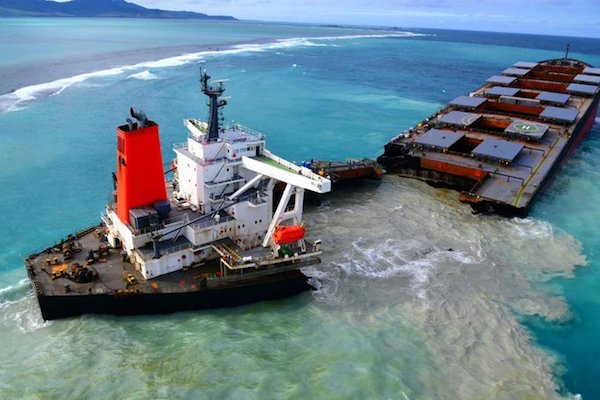
And here’s an aerial view, showing the nasty effects of oil on Mauritius’ turquoise water:
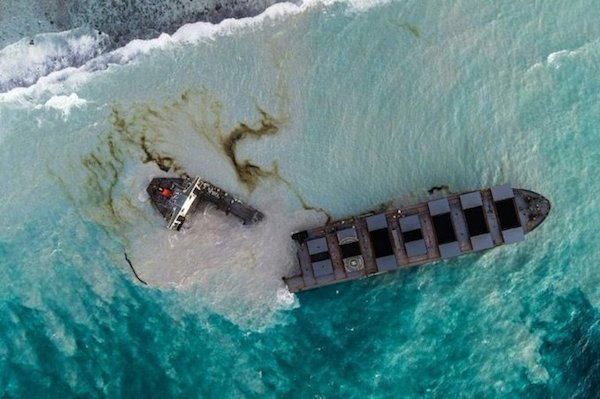
(Most of the oil was removed from the tanker before it broke up, so this photo shows the vile residue.) A few days ago, Yves covered the grounding, the ecological effects, the (mostly successful) efforts to pump the low sulfur and diesel oil out of the ship to keep it out of the ocean, and the volunteer efforts to clean up the oil that did escape; she also gave a link to a crowd-funding site for cleaning and protecting the Mahebourg Lagoon[3] where the oil spilled. In this post, I’ll look at what we know today about how the Wakashio ran aground, the nature of the oil spill, and compensation for the spill.
How and Why the Wakashio Ran Aground
One’s first thought (well, my first thought) was the oddity of a ship grounding on an island in the middle of nowhere. In fact:
Mauritius is next to one of the world’s most concentrated shipping lanes, which connects Asia, Africa, Europe and Latin America. During the month of July, more than 2,000 vessels passed close by the Mauritian coast.
Bloomberg writes, in “Why So Much World Trade Passes Mauritius’s Pristine Beaches“:
[Mauritius lies] on the shortest straight-line route between the Strait of Malacca, which links the ports of Asia to the Indian Ocean, and the southern tip of Africa. That also makes it the route of choice for shipping between the huge markets and manufacturing centers of China, Japan, South Korea and the rest of Asia in the east, and the resource-rich regions of West Africa and Latin America, or the markets of Europe and North America, in the west.
In short, if a freighter is sailing between the eastern and western hemispheres, there’s a good chance that it will get somewhere close to the island. The main alternative route is to navigate Egypt’s Suez Canal.
Of course, “close to the island” should not mean “colliding with the island,” and so the question becomes why the Wakashio’s voyage ended in disaster. There seem to be two points of failure:
1) The change of course on July 21. Forbes provides satellite-driven data analytics on the course change:
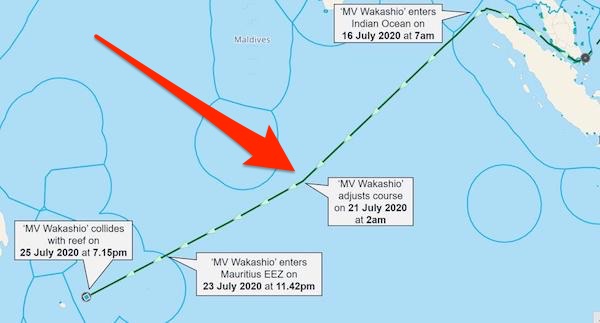
So far, nobody knows why the change of course occurred. From Splash 24/7, “Countdown to disaster: why did the Wakashio deviate from its intended course?”
What also remains unclear is the decision taken by the Wakashio to deviate course on July 21. Vessel tracking from Splash partner MarineTraffic clearly shows that early in the morning of July 21, the newcastlemax [a Capesize hull form] owned by Japan’s Nagashiki Shipping, changed route, putting it on a collision course with the pristine shores of the island republic of Mauritius.
And in fact, the captain believed he was on the right course:
As Splash has earlier reported, the coast guard in Mauritius had tried in vain to contact the ship’s captain for an hour on the evening of July 25 to warn that its routing looked dangerous. When finally coast guard officials got through to the master, the captain insisted the planned route was safe. A few minutes later, however, the ship radioed local authorities to say the vessel had grounded on a reef.
(Apparently, the course was meant to keep the Wakashio ten miles from shore, which to me is cutting it pretty close to me in a big ocean). And the second point of failure–
2) The debacle on the reef. Posters at an entertaining forum on gCaptain (which seems to be the maritime equivalent of PPRUNE) point out that if the Captain had looked out the window, he would have seen lights; the lights, in fact, of Sir Seewoosagur Ramgoolam International Airport, the main international airport in Mauritius:
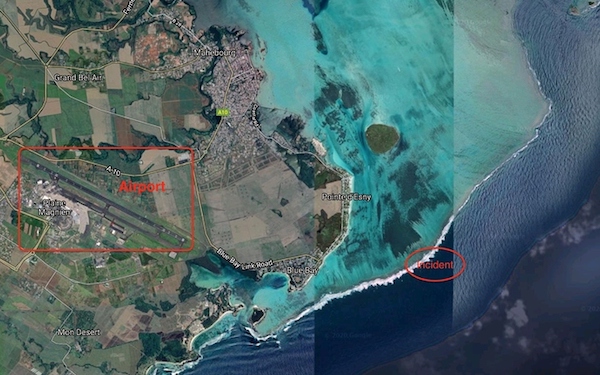
They also point that that had the caption taken a trip out onto the bridge wing and listened, “those breakers could probably be heard miles away.”
So what happened? The answer is not edifying (and will cost Nagashiki Shipping’s insurer a good deal of money, if there’s any justice in the world. From Splash 24/7, “Birthday party and quest for wifi revealed in lead up to Wakashio grounding off Mauritius“:
The 58-year-old captain of the ill-fated newcastlemax Wakashio could face negligence charges after it emerged the crew were celebrating a crewmember’s birthday and had headed nearer towards the Mauritius coastline to get a wifi signal just prior to the bulk carrier’s grounding on a reef off the island’s south coast.
The bombshell revelations – first reported by local newspaper L’Express – come from investigators who have interviewed the crew of the Japanese-owned, Panamanian-flagged ship.
The party also explains why local authorities tried “in vain to contact the ship ahead of the accident to warn it was on the wrong course,” and why nobody looked out the window or walked out on the wing of the bridge.
(Here I will interject that blaming the workers is always easy, especially given the temptation to moralize over partying. Debacles like this are generally the ugly conclusion of “a series of missteps,” and here we really need to know why the course change happened, and we don’t.)
The Nature of the Oil Spill
Here is a view of the spill:
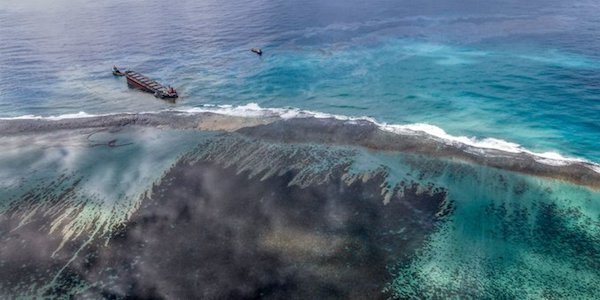
Here is drone footage of the spill:
A drone footage showing the extent of the oil spill in Mauritius by the bulk carrier, MV Wakashio.
Here’s a (regulary updated) carrd with more in-depth information and several links on how to help, please spread 🙏🏼: https://t.co/8HHKN5F4QZpic.twitter.com/djHjRFzx7N
— BTS Mauritius⁷ (@BTSMauritius) August 10, 2020
Here is what the spill looks like on the beach, when collected in buckets:
A Mauritius resident shows dozens of buckets and drums filled to the brim with sandy oil on the beaches as volunteers try to clean up the spill pic.twitter.com/5viFSH7Gag
— Reuters (@Reuters) August 12, 2020
And here is a map of the ten-square-miles spill from Reuters:
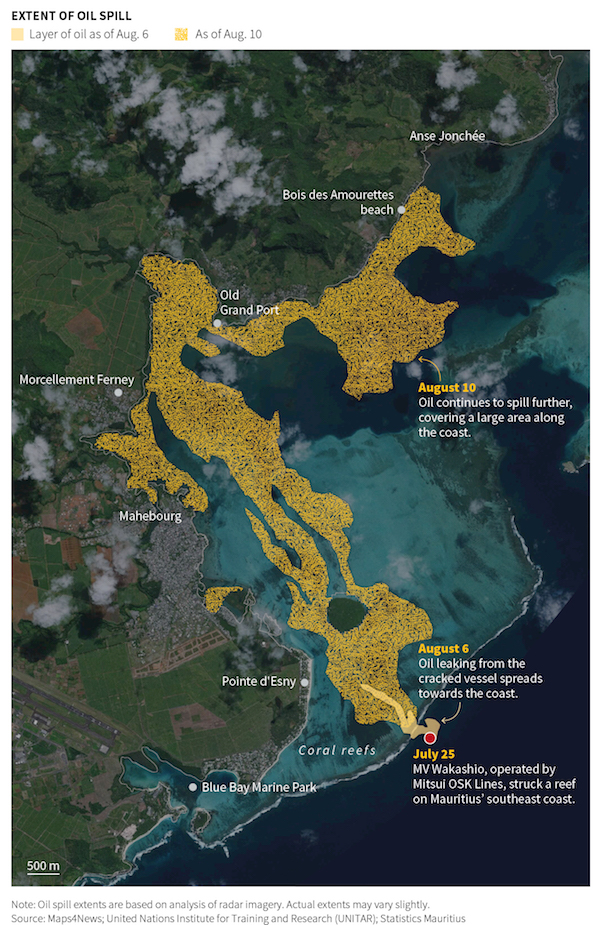
The ecological effects of the spill wil not be good, as the BBC points out:
“There are very few such marine areas with such rich biodiversity left on the planet. An oil spill like this will impact almost everything there,” said Dr Corina Ciocan, a senior lecturer in marine biology at the UK’s University of Brighton.
“It is not just about the light oil slick you see on the surface of the water caused by the spill.
“There will also be soluble compounds from the oil that will dissolve in the water, a mousse-like layer underneath the surface of the water, and then very heavy residues on the bed – so the entire marine ecosystem will be affected.”
Forbes has an excellent explainer on the actual oil spilled, in Nishan Degnarain’s “Toxic In The Tropics: The Invisible Killer Now In Mauritian Waters After Major Heavy Oil Spill“:
In the case of the Wakashio in Mauritius, the vessel appears to have been carrying the heaviest type of bunker fuel, No 6 (Grade C) fuel, that requires special handling for cleanup operations, as NOAA’s guidelines for No 6 (Grade C) bunker fuel oil spills indicate.
Although Heavy Fuel Oil is the most common form of oil used in shipping, there is significant controversy about its use and there have been strong efforts to have it banned both in order to meet Climate Change commitments, as well as the risk to the environment. Spills from Heavy Fuel Oil are more common than Crude Oil spills due to vessel accidents, poor maintenance or vessels cleaning their engines illegally at sea, so do not receive as much media coverage. Although visually, Heavy Fuel Oil Spills are much lower volumes than Crude Oil spills (as vessels are not transporting oil), so spills are a lot less visible on the ocean surface, they can be extremely toxic.
The risk of HFO spills are so toxic that the they are already banned from Antarctica (just South of Mauritius) and the international shipping regulator, the International Maritime Organization based in London, is finalizing plans to have it banned from the Arctic in the next few years due to the fragile nature of the Arctic ecosystem, and high exposure to ultraviolet light from the sun, that makes it even more lethal.
Unfortunately for Mauritius, the situation is even worse than Degnarain makes out: The oil is not merely bunker fuel, but low sulfur bunker fuel, which is even harder to clean up than horrid normal bunker fuel. From a report by SINTEF, a Norwegian research company, “Characterization of Low Sulfur Fuel Oils (LSFO) – A new generation of marine fuel oils” (PDF):
The [Low Sulfur Fuel Oils (LSFOs)] investigated in this project and previous limited studies have showed a wide span in the oil properties with relevance to behaviour when spilled at sea. Moreover, the oils tested indicate a high degree of persistence on the sea surface, and the oil spill response can even be more challenging than the previous traditional intermediately fuels oils (e.g. IFO180 / 380), particularly in cold water spill situations:
- The effectiveness of using dispersants may be limited due to either high viscosities of the emulsions and/or high pour point of the oils
- The potential for use of ISB can be limited as the ignitability may be slow (i.e. extended ignition time) due to low contents of volatiles. Small amount of water uptake (emulsification) may also prevent the oil to be ignited without use of significant amount of primers (e.g. diesel)
- The effectiveness of mechanical recovery is dependent on the choice of skimmer system that force contact between the oil and the recovery unit. Oils with high pour points will e.g. need an “active” high viscosity or belt skimmer designated for solidified oils at sea
The cosmic irony here is that the shipping industry has been switching to low sulfur fuel in order to reduce its very bad contribution to air pollution.
Compensation for the Spill
Finally there is the issue of how much Nagashiki Shipping will compensate Mauritius for the spill. From Agence France Presse:
The ship’s owner has meanwhile pledged to “sincerely” respond to requests for compensation over damage to the marine environment.
“We are deeply conscious of our responsibility as a party directly involved in the case,” said Kiyoaki Nagashiki, president of Nagashiki Shipping.
“Regarding compensation, we plan to deal with the issue sincerely based on applicable laws,” the head of the Okayama-based company said in a statement.
(If I heard a US firm pledge to do something “sincerely” I’d run screaming from the room, but I don’t know the implication of that choice of words for a Japanese firm.) Of course, taking responsibility means putting a number on the damage, which may take a long time. From the Japan Times:
Nagashiki Shipping will bear the liability for damages as it owns the ship…
Two treaties regarding marine accidents require ship owners to purchase a public liability policy, while setting a limit on the amount of damages a ship owner pays.
With the insurance policy Nagashiki Shipping holds, the company is expected to be asked to pay up to $1 billion (¥107 billion), over the oil spill. There is no limit on costs the company has to pay to remove the vessel.
The amount of damages may be limited to about ¥2 billion based on the treaties. But Nagashiki Shipping may have to pay more if its serious faults are found, according to an insurance industry employee.
Nagashiki Shipping may have to pay compensation for damage to wildlife as well as people in the fishing and tourism industries. It is likely to take time to determine the total amount of damages.
Tourism generated 63 billion rupees (¥168 billion) for the economy last year.
I don’t know how to sort this out; the difference between ¥2 billion vs. ¥107 billion vs. ¥168 billion (per year, albeit pre-Covid) is pretty big. Then again, the whole question of whether monetary compensation for ecological damage is even possible. From the Mauritius Times, “Prof Christian Bueger: ‘Mauritius will receive some basic compensation. But how do you calculate the price of restoring a marine habitat, or the cost of a dead bird?‘”
Based on other oil spill litigation cases, financial compensation will firstly take a long time. The destruction needs to be economically calculated, and responsibilities and obligations clarified. Mauritius will receive some basic compensation.
Yet, how do you calculate the value of an eco-system, the price of restoring a marine habitat, or the cost of a dead bird? Whatever compensation received it will not do justice to the damage done. Ocean recovery will take years, if not decades. And let’s not forget the reputational damage, and the consequences for tourism in Mauritius as well.
(This feeds into the whole question of “ecological services,” a term rife among Blue Economy proponents, which in my understanding assumes, even demands, that a price be put on such services.)
Conclusion
I hope Mauritius gets plenty of help with international relief[4] a nice chunk of change from Japan, even if it’s not precisely calculable. And it’s tragic that the very human desire for a WiFi connection to crew’s families, and a birthday party, resulted in such a tragedy[5]. Finally, it really would be better to leave the oil in the ground.
NOTES
[1] Kyodo News: “Pointe d’Esny, an area designated as a wetland of international importance under the Ramsar Convention, which is close to Blue Bay Marine Park, another Ramsar site.”
[2] The oil leakage proper started on August 6.
[3] CBS, quoting Jean Hugue Gardenne of the Mauritian Wildlife Foundation: “We have planted about 200,000 indigenous trees to restore the coastal forest. We re-introduced endangered birds, including the pink pigeon, the olive white-eye and the critically endangered Mauritius fody to the Isle aux Aigrettes. Now all this is threatened as the oil is seeping into the soil and the coral reefs.” See here at NC on coral reefs, here on mangrove forests, and here on coastal estuaries.
[4] Mauritius also occupies a strategic position in the Indian Ocean, near Diego Garcia. There’s no suggestion this had an impact on the grounding, but it may have affected the nature of the relief effort — no British or US help, other than US embassy volunteers helping to clean the beaches — but help from India and France.
[5] I have not looked into the actions of the Mauritian government, because a lot of the material is in French, which I don’t read. However, gGaptain, in “Wakashio Grounding and Oil Spill: Was the Mauritian Government Unprepared?” provides a bill of particulars and answers that Mauritius was prepared, given its capacity as an island nation of 1.3 million people. This is also the first time Mauritius has been hit with an oil spill.


















